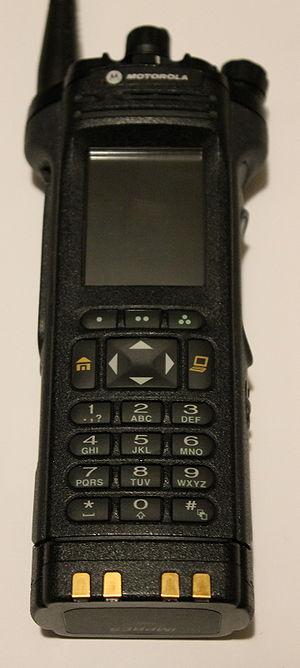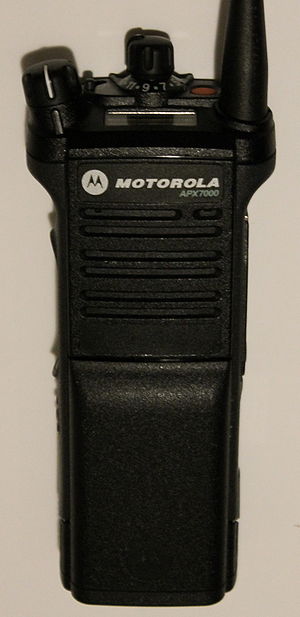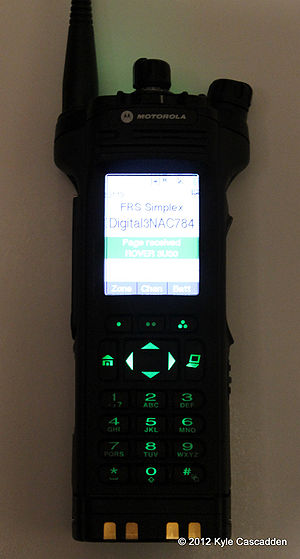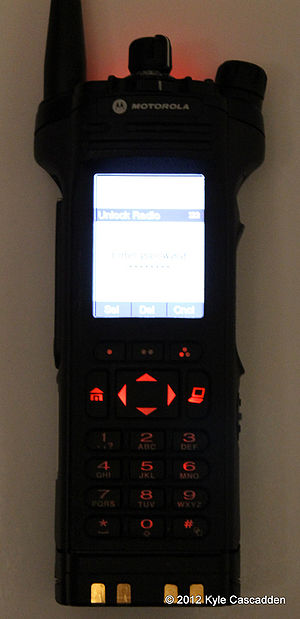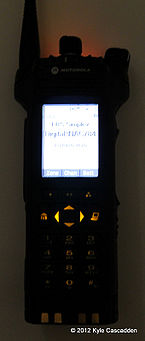APX 7000
From The RadioReference Wiki
Template:TOC hidden The APX7000 is Motorola's first dual-band, portable, public safety radio and is the most recent product in the Apex Family of radios (along with it's ruggedized counterpart - the APX7000XE).
Contents
Basic Features and Physical Build
Like most other public safety radios produced by Motorola, the APX7000 has a volume knob, a channel knob, three programmable side buttons, a two-position concentric switch (ø/o switch), a three position mode switch and an orange "emergency" button, and PTT button, all of which can be programmed to the user's liking (with the exception of the PTT button). It is produced in two basic models; the model 1.5 which features an 8-character, multi-colored backlit display on the top of the radio without any numeric or navigation keys, or the model 3.5 which features the above-mentioned top display as well as an LCD front display, full numeric keypad , four-way menu navigation keypad, home button, data button, and three menu-selection buttons.
As mentioned previously, the APX7000 is the first portable radio produced by Motorola with the ability to operate in any two of the four public safety bands (VHF, UHF1, UHF2, 700/800MHz).
The APX7000 boasts a 1 watt main speaker as well as a secondary speaker on the display side of the radio, both of which can be turned on or off independently based on the user's preference. The radio also has a microphone mounted near each speaker, making for two noise-cancelling microphones designed to suppress wind, feedback and other non-voice noises in the user's environment.
On both the top-display and dual-display models of the APX7000, an integrated GPS comes standard. On the dual-display model, the user can view their exact coordinates as well as set waypoints, "home" and destination coordinates. CPS enabled features like pseudo-locationing and emergency "keep-alive" GPS transceiving are also available and programmable on the face of the radio.
The APX7000 is the first radio to be offered by Motorola that is able to have both front-panel programming (FPP) as well as trunking options enabled in the same flashcode.
Ergonomics
Along with the other members of the Apex family, the APX7000 was built with a "T-Grip" shape, for two main reasons; to make the radio more fitting and slip-resistant to the user's hand (even while wearing gloves), and to make space for the 8-character top display while still having room for the standard top-mounted controls.
The side controls (Purple button, PTT button, (•) button, and (••) button) have raised edges making them easily identifiable and distinguishable to the user.
The APX7000 is capable of on-board Bluetooth connectivity to Motorola's full line of "Mission-Critical Wireless" devices, as well as third-party Bluetooth headsets. Certified devices are capable of keeping the connection between the APX7000 and Bluetooth devices as secure as the radio's transceiver and therefore not compromising encryption with the use of a wireless headset.
On-Screen Symbols
ARS Data Registration Logged-in symbol ![]() , and not logged-in
, and not logged-in ![]()
Battery Meter ![]() , Low Battery
, Low Battery ![]() (for IMPRES-compatible batteries only)
(for IMPRES-compatible batteries only)
High Power Symbol ![]() , Low Power Symbol
, Low Power Symbol ![]()
Monitor (Carrier Squelch) symbol (Conventional only) ![]()
Secure Hardware Operation symbol ![]() , AES operation
, AES operation ![]()
Scan symbol ![]() , Priority Scan symbol
, Priority Scan symbol ![]() , Voting Scan symbol
, Voting Scan symbol ![]() ,
,
RSSI (Received Signal Strength Indicator) Symbol ![]()
Intelligent Lighting
Possibly the most flashy and informative new feature of the APX7000, is its "intelligent lighting". The radio's multi-colored backlit keys, top display and LCD screen use colors to alert the user of the radio's state at a glance. The display has a backlit state of four colors (Green, Red, Orange and White) which make up the radio's status at all times. In all of these intelligent lighting states, the top display and keypad will turn entirely one of the four colors, while the main (LCD) screen will display a band of the same color for a lower portion of the screen, along with detailed information about the notification.
Green
This is used to show a call or page has been received for the radio. This can be through MDC, Astro, Type II trunking, or P25 calling/paging systems. When a select call is received, the green band will show a green band with the words "Call Received" on one line and "CA: [User ID]" on the second line. Similarly, when a page is received, the radio will display a green band with the words "Page Received" on the first line, and "ID: [User ID]" on the second line.
Red
As the natural reaction to the color is, red is a bad sign and is used to indicate three states of the radio;
- Out-of-range (Trunking Only)
- When the radio cannot connect to a trunked system due to incorrect programming parameters or geographic impossibility.
- Low Battery
- The radio's battery is below 10% rated capacity (or 15% in the case that the user has selected to use an "early warning" low battery alarm).
- No Comms (Trunking only)
- This indicates that the radio tried to affiliate on a trunked system and was actively rejected from the system (usually due to an invalid ID or incorrect programming parameters). In this state the radio is unable to transmit or receive.
Orange
The color orange is used to signify an emergency call. The radio's top display and keys light up orange and the screen will display an orange band along with the ID of the radio which initiated the emergency call. An example of a radio receiving an emergency call can be found here.
White
The basic, idle state of the radio's backlighting is white, which indicates that the radio has not been triggered to change to any of the above states. This means that the radio is not out-of-range (trunking only), has not been rejected from a system (trunking only), is not low battery, has not received an emergency call, private call, or page from another radio.
"Forwards and Backwards Compatibility"
Part of Motorola's advertising for the APX7000 included the radio's interoperability both "forwards and backwards" meaning it works with current, future and past standards. This is true of the radio's ability to use several trunking protocols (Motorola Type II, SmartZone, OmniLink Multi-Zone, Smartnet, Project 25 Phase 1 (FDMA) and Phase 2 (TDMA)), and of the radio's ability to use analog or digital APCO CAI (common air interface/AMBE/IMBE) voice and data, and finally of the radio's ability to operate in three channel spacings: 25, 20 and 12.5 kHz.
Being that the APX7000 is capable of APCO Project 25 Phase 2 standards, it is capable of Over-The-Air Rekeying (OTAR) and Over-The-Air Provisioning (OTAP) for changing encryption keys and basic codeplug reprogramming without leaving the user's hand.
Encryption 
The APX7000 is certified to FIPS 140-2 level 3 security. It is capable of AES, DES, DES-XL, DES-OFB and ADP encryption algorithms for interoperability with older algorithms as well as ones in current use. More info on encryption protocols can be found here.
COPYRIGHT NOTICE
The APX7000, APX7000XE, APX7000R, XTS5000, SmartZone, Smartnet, OmniLink, MDC, IMPRES, APX series and Astro series are registered trademarks of Motorola (1995-2011) and Motorola Solutions, Inc. (2011+).
All images marked as such are copyright of Kyle Cascadden (2012) and are authorized for creative commons, non-commercial reproduction.
